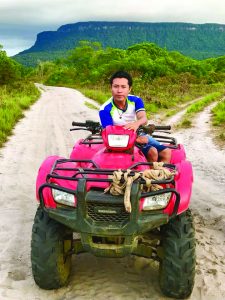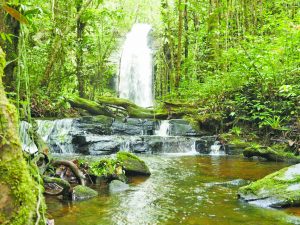By Lakhram Bhagirat
“I have noted the need to preserve my culture and that is exactly what I want to do. I want to become a voice for the Indigenous community and I will use my camera to achieve that. I want to become that advocate and to share the stories that excite us, stories that show our way of life, stories that highlight the issues we face, and stories that preserve our culture,” said the vibrant Chris Elliman.
Chris has been working for a number of years to share the stories of life in his village, Paruima.

Paruima is an Amerindian settlement with a population of about 800 persons and is located in the Upper Mazaruni District of Region Seven (Cuyuni-Mazaruni). Paruima is said to be the only Arecuna-speaking community in Guyana though Chris said the village is now home to many other Amerindian tribes.
For Chris, growing up in Paruima was an experience he would not trade for anything else. His early days were centred around school, gardening and church. For the villager, religion is of paramount importance and most of them are from the Seventh Day Adventist denomination.

As a child, Chris spent hours helping his parents in their garden, which was the only source of income as well as feeding the family. The 31-year-old said that his initial schooling was done mostly in the village but after he sat the Common Entrance Examinations, he was offered a place at President’s College in Georgetown.
For him, that was perhaps one of the scariest times in his life because of the fact that he had never interacted with coastlanders. He was mostly reserved and shy and that was quite evident when he began classes at his new secondary school. However, after a few years, he felt at home and began having fun.
“Life in secondary school was hard for me. I had to leave my village and my family behind and it was hard because I could not take the loneliness. My parents never worked so there was also the issue of finances. When it was CXC time I wrote 5 subjects and was only able to secure 3 of the 5 because I passed through a lot where the dormitory was burned down. I lost everything and I gave up on that day. I saw that my parents could not afford to get back the books and so.”
“When I returned home for the holidays I told my father that I don’t want to return to the school because I know he could not afford to buy the things I needed but he encouraged me to go back and told me to see what I can do and complete and that no one is going to pressure you.”
After he finished secondary school, Chris worked for a while in the city before moving back to his home. When he got back, he became engrossed in taking care of his family and to this day, he still helps in whatever way he can.

Paruima is heavily dependent on self-sustenance since job opportunities are very limited. So villagers would plant their gardens and whatever they cannot consume they would, in turn, sell, which serves as their main form of income. For Chis, it was this simple life he enjoyed.
However, he has always had a knack for technology and loved cameras. He wanted to become a videographer and now he is a part of the Amerindian Peoples Association (APA) Youth-led Media programme which allows him to fulfil that dream.
With funding from the Norwegian Agency for Development and Cooperation (NORAD), the Youth-led Media project is one that focuses on developing the skills of Indigenous youths in the field of media and communications, primarily in film and video production. At present, the project involves youths from Santa Rosa, Region One; Wakapao, Region Two; Waramadong and Paruima, Region Seven; Paramakatoi, Waipa and Kato, Region Eight; and Aishalton in Region Nine.
The youths are given the knowledge and tools to become their own storytellers and share the issues affecting the Amerindian communities. They are encouraged to highlight the livelihoods and the culture of the Amerindian people.
Before the APA’s Youth-led Media project came to par, Chris was doing exactly that. He had his little camera and whenever there were events or anything that excited the village, he would capture those moments. He would then transfer those videos onto DVDs and sell them as a way of making money.
“Persons in the Upper Mazaruni got to know about the DVDs and it grew. Even some neighbouring villages in Venezuela would be requesting DVDs. I stopped after a while and that was what led the APA to ask me to join the Youth-led Media programme.
“At that time when they asked me I was looking at ways to become a videographer and they had people come on from the USA to show us how to compile our stories and we are here still learning.”
Since he became a part of the programme in 2017, Chris has had to move to neighbouring Waramadong because his village lacks stable internet connection and cell signal. Despite moving, Chris’ heart remains in Paruima and he has been making his mark in Waramadong as well.
He has been volunteering his IT skills at the DC Caesar Fox Secondary School.
Now Chris dreams of becoming a bigger voice for his people as he seeks to highlight the culture that makes them unique. He is on the path to ensure that the issues affecting the Indigenous communities are addressed or at least placed in the public domain.
“You always have to do something you enjoy. I enjoy film and I am happy that I am given this platform to make sure that our voices, our stories, our culture is out there.”











